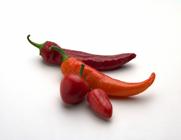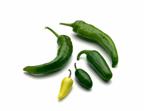
|
|
|

|
|

|
Chomping Down The Chiles
 Heat Sensors
Heat Sensors
Chile Descriptions
Altering the Heat
Putting Out the Flame
Roasting and Freezing Chiles
Heat Sensors
Chiles, an essential food in Mexican cooking, come in a variety of sizes, colors, shapes, and most importantly in food use, heat levels. The heat level in chiles is judged by a high-tech sensory process called Liquid Chromatography. The machine measures the capsaicin content (the stuff that makes chiles hot!) of various peppers in parts per million. In 1912, Wilbur Scoville used a panel of five human testers to determine the hotness of chiles. They came up with the original Scoville Scale. Today's more accurate measurements are still converted into Scoville units, probably to give continuing credit to Mr. Scoville and his brave panelists who suffered the scorching heat of chiles to determine their fire in the early 1900s.
Some people really can take the heat while others cannot. And, while chiles have different flavors beyond the heat, if you're tongue can't take the initial burning, you'll never keep the chile in your mouth long enough to experience their earthy, floral, sweet, or smoky flavors. For this reason, I think it's more important to find peppers within your heat-tolerant range to use in recipes, instead of choosing the exact chile specified, even though its after-burn flavor may complement the meal more. I've included the Scoville Scale below to help you find the chile within your tolerance range, and then, it's just plain interesting, too!
| Scoville Units Scale |
| Mild |
0-5,000 |
| Medium |
5,000-20,000 |
| Medium |
20,000-70,000 |
| Hot |
70,000-300,000 |
| Extremely Hot |
300,000+ |
| Chile Type |
Scoville Units |
Bell pepper & Pimento & Sweet Italian
Ancho
New Mexico
Anaheim
Cherry Hots
Passilla
Poblano
Jalapeno
|
0
1,000
1,000
1,000-1,400
1,500-2,500
2,500
2,500-3,000
3,500-4,500
|
Guajillo
Puya
Serrano
Chipolte (smoked jalapeno)
|
5,000
5,000
7,000-25,000
10,000
|
de Arbol
Japone
Cayenne
Tabasco
Chiltecepin
|
25,000
25,000
35,000
30,000-50,000
70,000-75,000
|
Pequin
Aji
Habanero, Scotch Bonnett
|
75,000
75,000
200,000-300,000
|
Chile Descriptions
 *Ancho: dried, red poblanos, wrinkled skin and flat, wide shape; these are most often ground into chili powder and are also used in mole sauces and stews like chili con carne; to use, toast in a 300-degree F. oven for about 8 minutes, soak in water to rehydrate, and then remove stems, seeds, and skin.
*Ancho: dried, red poblanos, wrinkled skin and flat, wide shape; these are most often ground into chili powder and are also used in mole sauces and stews like chili con carne; to use, toast in a 300-degree F. oven for about 8 minutes, soak in water to rehydrate, and then remove stems, seeds, and skin.
*New Mexico: a green chili, similar to Anahe im, and used in canning; heat level varies; ripens to a red color and is often dried; toast and use dried chiles as directed under Ancho chiles.
*Anaheim: mild to medium heat; sweet flavor; used in red sauces and also in canning; thin skin makes them more difficult to stuff than poblano chiles; also used dry (red when dry).
Cherry Hots: meaty, round, red chiles used to add hotness to pepper jellies and relishes; also used in making salsas, stuffing, and pickling.
Pasilla: dark, reddish brown, and wrinkled, sometimes known as chile negro. Rich, deep flavor; good in hot sauces.
*Poblano: deep green and ripens to brick red color; large and almost bell-shaped; needs to be roasted and peeled before use (see roasting and freezing chiles); good for stuffing, dicing, and tossing into soups, sauces, and quesadillas.
*Jalapeno: mild to medium heat, depending on where it's grown and growing conditions; grassy, green flavor when used green, and sweeter when allowed to ripen to red color.
*Guajillo: a dried chile native to Northern and Central Mexico; used in sauces.
Puya: a Mexican Indian chile; slender, 3-4 inches in length, with sharp, intense flavor
*Serrano: a green chile hotter than the jalapeno; gives off a vegetable taste with undertones of citrus; used chopped or pureed with the seeds in salsas and marinades.
*Chipotles: dried, smoked red jalapenos, often found canned in a smoky, hot, hot sauce; good in barbecues and meat sauces.
de Arbol: slender, 3-inch long, bright, brick colored chile that is a native of Mexico; very hot with an almost tannic, smoky, sharp flavor; most often dried and ground into powder to add to red chile sauce; also used cooked and pureed in salsas and sauces
Japone: used in Asian cooking; red, long.
Cayenne: used extensively in Indian and Indo-Chinese cookery; long, thin, tapering to a sharp point; dried and ground into powder for seasoning.
Tabasco: originated from the Mexican Tabasco state; bright red, small chile mostly grown for hot sauce.
Chiltecepin: also known as tepin; believed to be the mother plant from which all other chiles derived; berry-like, just over the size of a peppercorn, and scarlet in color and extremely hot.
Pequin: very tiny chiles and extremely hot; similar to chiltecepin.
Aji: term used for a variety of species; similar in flavor to the habanero; used to create extremely hot salsas and sauces
*Habanero or Scotch Bonnet: small and bell shaped chiles found in red, green, or orange colors; hottest but most flavorful of all chiles; sweet, rich, fruity flavor, with tropical overtones; most flavorful when ripens from a yellow to red color.
*Chiles most requested in Mexican recipes.
Altering the Heat
When cooking with chiles, keep in mind that the vein and the seeds are highly concentrated in capsaicin. You can adjust the heat levels of foods by either adding or omitting these parts of the chile.
Also, it's imperative to wear thick rubber gloves when cutting hot chiles. Their potency burns hands horribly, to which only time is a remedy. Thin gloves sometimes just aren't dense enough to keep out the burning. I tried them a few years back and suffered much agony for two or more hours until the heat finally subsided from my hands. I just learned that vinegar may help alleviate the pain if your hands do get burned.
While wearing gloves, be cautious of what you touch--no children, babies, eyes, doorknobs, etc. A coating of shortening or other fat may also help prevent burns.
Putting Out the Flame
You're mouth is on fire and you're about to scream. Your friends are laughing at the joke they just played on you with that habanero you just ate, and each is offering you something to put out the inferno. Which will be your best choice?
 a) cool glass of ice water a) cool glass of ice water
b) large glass of whole milk
c) large glass of skim milk
d) alcoholic beverage
e) a serving of starchy foods, like bread, potatoes, or rice
If you grab a glass of water, you'll still be spewing flames. Capsaicin doesn't dissolve very well in water; it is soluble in oils and alcohol, however. The large glass of whole milk, with its high fat content, rinsed in the mouth, will extinguish the fire quickest. A spoonful of sour cream, whole milk yogurt, or ice cream, would work the same. The skim milk, with no fat content, and low-fat dairy products, would work about as much as water. The alcoholic beverage would cut some of the flames, and the starchy foods, sloughing the capsaicin off your tongue, would be a slower, but eventually successful method of snuffing the fire.
Roasting and Freezing Chiles
 To bring out flavor and remove tough skins (like on Anaheims and Poblanos), recipes often request roasted peppers. You can use either the oven or grill to char the skins. To bring out flavor and remove tough skins (like on Anaheims and Poblanos), recipes often request roasted peppers. You can use either the oven or grill to char the skins.
For both methods, first cut a small slit close to the stem of each chile to let the steam escape. For the oven method, turn the broiler to medium-high heat. Place the chiles on a baking sheet directly under the broiler. To grill, place about five or six inches above the heat source. Watch and broil/grill the chiles, turning them, until they are blistered and charred black on all sides, but skins should be.
Once charred, place the chiles in a paper or plastic bag, close, and let them steam until cool enough to peel. Peel the chiles, starting from the stem end; the skins should slip off. Some peel under running water but expect some loss of flavorful juices if you do this.
You can freeze the chiles before peeling. When you remove them from the freezer, the charred skin will slip right off. Cool the blistered chiles before packing them in plastic bags or aluminum foil. Remove them as needed.
If you prefer not to roast your chiles, you can freeze them with no blanching or other preparation. Simply clean the chiles, leave whole, chopped, or diced, and pack them into containers leaving 1/2-inch head space. Some chiles may get mushy upon thawing, but typically, since they are used in purees or sauces, this isn't a problem.
|
* DVO welcomes your kitchen hints and cooking or nutrition questions! Email us and we'll post your hints and Q/A's in upcoming newsletters! *
|
|
















 *Ancho: dried, red poblanos, wrinkled skin and flat, wide shape; these are most often ground into chili powder and are also used in mole sauces and stews like chili con carne; to use, toast in a 300-degree F. oven for about 8 minutes, soak in water to rehydrate, and then remove stems, seeds, and skin.
*Ancho: dried, red poblanos, wrinkled skin and flat, wide shape; these are most often ground into chili powder and are also used in mole sauces and stews like chili con carne; to use, toast in a 300-degree F. oven for about 8 minutes, soak in water to rehydrate, and then remove stems, seeds, and skin. a) cool glass of ice water
a) cool glass of ice water To bring out flavor and remove tough skins (like on Anaheims and Poblanos), recipes often request roasted peppers. You can use either the oven or grill to char the skins.
To bring out flavor and remove tough skins (like on Anaheims and Poblanos), recipes often request roasted peppers. You can use either the oven or grill to char the skins.